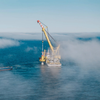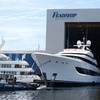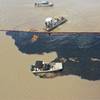Navy Installs First Onboard Ship Protection System to Thwart Terrorist Attacks
Development and procurement of the SPS is being managed by the Anti-Terrorism/Force Protection (AT/FP) (PMS 480) office within the Program Executive Office for Littoral and Mine Warfare (PEO LMW).
With its layered AT capability, the SPS will allow the ship’s commander to conduct surveillance, track, and evaluate identified threats and respond appropriately beginning with a non-lethal response and progressing to lethal defensive actions as necessary. In the Cole incident, the ship was not equipped to identify and track small craft, ascertain intentions, warn or thwart the attack with a weapon system that was commensurate with the target. According to Rick Skillman, SPS integrated logistics support manager,
“SPS pulls together a number of COTS (commercial off-the-shelf technologies) into an integrated package of command and control software, sensors, tactical decision aids, warning devices, and weapons to provide a full-range defensive capability to naval surface combatants against asymmetric threats.” By utilizing COTS and common architecture for software and hardware, the Navy is shortening the timeline and reducing the costs associated with systems development and acquisition.
“Being able to focus on integration of existing technologies, as opposed to developing these technologies, provides obvious time and cost savings,” says Kelly Donegan, Assistant Program Manager for Shipboard AT Systems. “The challenge is in coordinating these technologies to provide a comprehensive capability to the warfighter to meet an urgent operational need.” The SPS is modular, expandable, and allows installation and operation on multiple ship classes and platforms with no increase in manning requirements. When SPS reaches low-rate initial production — or “milestone C” — in fiscal year 2009, it will consist of an integrated package of five major components.
• Two command and control consoles, one in the ship’s combat information center and another on the bridge, will display surveillance, environmental, and tactical information required by the commander, onboard watch officer, or other AT/FP decision-maker.
• Electro-optical/infrared (EO/IR) ball devices and other sensor systems will provide integrated surveillance, detection, and tracking capabilities against a full range of asymmetric threats.
• Non-lethal effectors consisting of acoustic hailing devices and search lights or dazzlers may deter a potential aggressor. Hailing devices emit high-decibel sound as a warning. Dazzlers or search lights project very bright, concentrated light to discourage the approach of a swimmer, small boat, vehicle or assailant.
• Lethal effectors will be available for quick deployment when the aggressor ignores the non-lethal effectors. The lethal effectors (small-caliber guns on stabilized gun mounts) will be scaled to an asymmetric threat environment to avoid unnecessary collateral damage from firing the ship’s big guns in a “close-in” or high-traffic area such as a port.
• On-board data processing and communication electronics will collect, integrate, and analyze environmental and tactical information and provide post-mission analysis. “Little R&D has been involved in developing SPS because the technologies, like the EO/IR systems, already existed in the civilian or military sectors,” says Skillman. “Most of our work now involves testing and integrating the components into a seamless package of electronics, sensors, devices, and weapons.”
For design and engineering support, PEO LMW is using the expertise of Navy’s warfare centers, adds Skillman. The Naval Surface Warfare Center (NSWC) Dahlgren Division serves as the technical design agent for SPS, and NSWC Crane Division is the in-service engineering agent.
By Program Executive Office Littoral and Mine Warfare










